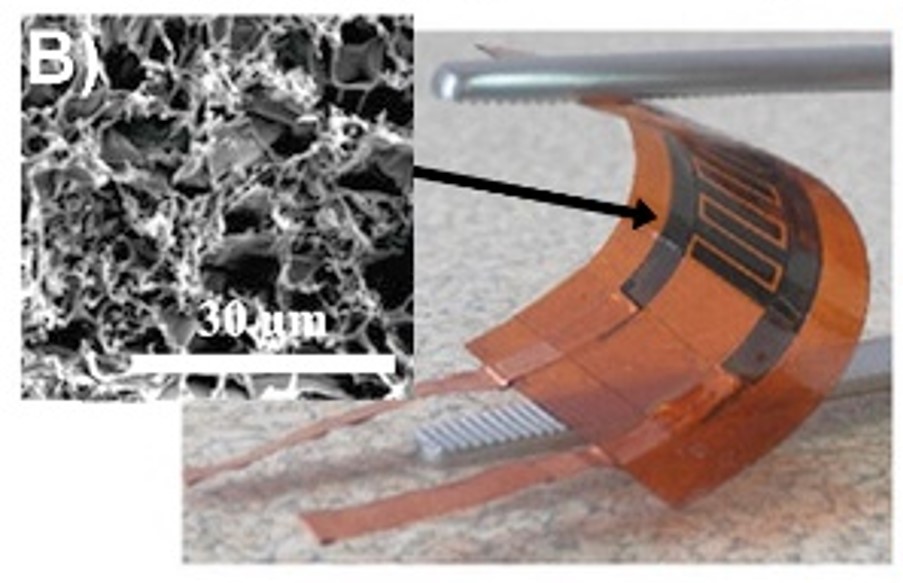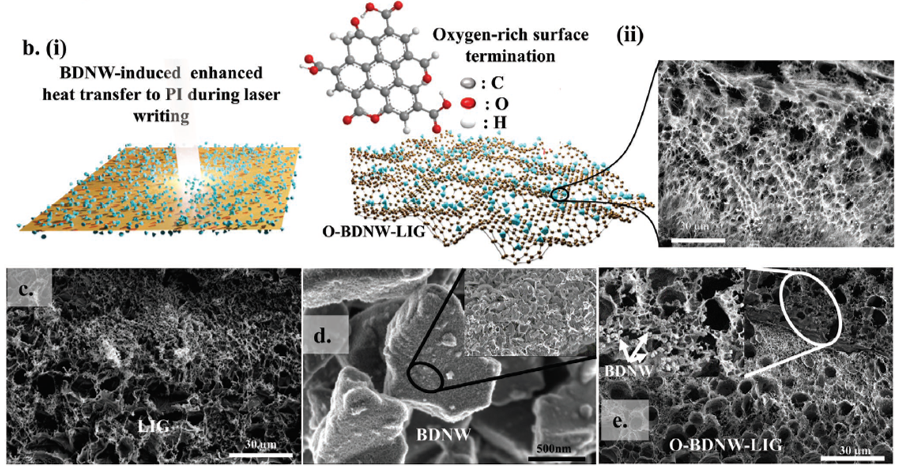about the LIGaletrt project
Sensing targets
Depending on the LIG structures parameters and the possibility of bio-functionalization (selectivity, sensitivity, reusability, resistance to external factors linearity), tests of the capabilities of LIG sensor technology to detect specific groups of substances will be carried out:
- primary explosives,
- secondary explosives,
- solid propellants,
- home made explosives
- chemical warfare agents simulants,
- selected factors related to the target operational scenarios.
Aims

The proposed LigAlert project aims to design and investigate selective laser-induced phase transformation of carbonaceous substrates (polyimide, textile) towards rapid detection of chemical weapons agents (CWA) and high energy materials (explosives) important for the army and public safety.
The project aims to develop and investigate a new generation of flexible (bio)sensors by fabrication of laser-induced graphene patterns on polyimide, then analyzing the mass and charge transport mechanisms throughout bio-layers, mechano-electric properties of this bi-layered system upon external stresses (elongation, torsion) or environmental aging.

Stage I:
- The fabrication of LIG patterns on polyimide is rare and their mechano-electric and electrochemical properties description regulated by the processing conditions.
- The material technologies are single-step procedures, easily scalable and obtainable through laser processing and 3D printing, to be used as free-standing electrochemical sensors.
- The impedimetric detection proposed is a unique approach to enhance specific interaction identification affected by the electric field and enhanced by numerical methods.
- The development of readouts system designed for single in-situ LIG bio-sensors.
- Recognition of the technology’s ability to detect various high-energy materials and other important military chemicals.
- Technology tests in the expected target scenarios of operational activities.
Stage II:
- Implementation of artificial intelligence algorithms in reading systems and testing the possibility of optimizing the parameters of LIG structures.
- The development of a technology for the fabrication of LIG sensor matrix structures.
- The development of the technology of deposition of layers functionalizing single sensors in the LIG matrix.
- The development of readouts system designed for matrix in-situ LIG sensors.
- Tests and recognition of the technology’s capability for military applications.
Hypotheses

- The novelty of our approach is based on decoding the 3D self-organization of the analyte molecules within the receptor-modified LIG structures into changes of the impedimetric response, occurring due to local disturbance of dielectric properties resulting from LIG pattern topography.
- The effect of structural properties affecting low-temperature electronic properties of LIG will also be elaborated.
- Next important element of the system is data acquisition system ensuring digital signal processing and implementation require analyzing algorithms including artificial intelligence (AI).
Work plan
- Materials Engineering and Synthesis:
- Fabricate LIG patterns on polyimide and textiles (USB and GUT).
- Analyze their mass and charge transport, as well as their mechanical and electrical properties under stress and aging (GUT and OSU).
- Synthesize peptide chains using solid-phase synthesis and recombinant expression in E. coli cells (JKU).
- Evaluate the quality of the peptides using NMR spectroscopy (JKU).
2.Design of Readout Electronics:
- Design and prototype the front-end amplifying circuits to match the characteristic impedance of the sensor and to maximize the signal-to-noise ratio (WAT).
- Test the developed electronics in the target application prototypes (WAT and GUT).
3.Data Acquisition and Processing:
- Convert analog signals into digital form using an ADC converter (WAT).
- Implement a custom software to match the impedance characteristics of the tested chemical compounds to a database of chemical substances (WAT).
- Transfer the solution to a selected microprocessor platform to miniaturize the processing system while maintaining computational speed (WAT).
4.Analysis of Impedance Data:
- Use dynamic electrochemical impedance spectroscopy (DEIS) to track dielectric property changes (GUT).
- Support data analysis with numerical tools such as principal component analysis and partial least square regression (WAT, GUT, CALTECH).


5.Testing and Validation:
- Test the LIG sensors with various high-energy, military-important chemicals (WAT and GUT).
- Record and match impedance characteristics to a database of chemical substances (GUT).
- Conduct tests on blank samples and determine equivalent electrical circuit models using heuristic algorithms (WAT).
- Examine the influence of temperature, pressure, and humidity on the measurement results and perform necessary durability tests (WAT, GUT and OSU).
6.Simulations and Artificial Intelligence Integration:
- Conduct DFT and MD simulations to understand behaviour of LIG structures and optimize selectivity (CALTECH).
- Implement artificial intelligence algorithms to recognize chemical compounds and determine their parameters based on impedance characteristics (WAT and CALTECH).
- Use a neural network as the basis of the intelligent algorithm and adapt its dimensions and parameters to the properties of the LIG sensors (WAT and CALTECH).
- Use a previously prepared measurement database of LIG sensor responses to dangerous chemical particles for network learning (WAT and CALTECH).
- Use genetic algorithms to speed up the learning process (WAT and CALTECH).
7.Matrix Sensor Array Readout:
- Focus on systems dedicated to reading sensor matrices (GUT).
- Serve the matrix sensor array with special front-end circuitry to ensure easy integration with destination devices (GUT and WAT).
8.Field Testing:
- Carry out field tests in conditions similar to operational scenarios (GUT and WAT).
- Evaluate the performance of the LIG-based sensors and make any necessary improvements (GUT and WAT).
- Ensure that the LIG sensors meet the project goals of improving the decision-making process in crisis management and enhancing the effectiveness of security measures by providing a reliable and efficient tool for detecting potential threats (GUT and WAT).
Previous slide
Next slide


